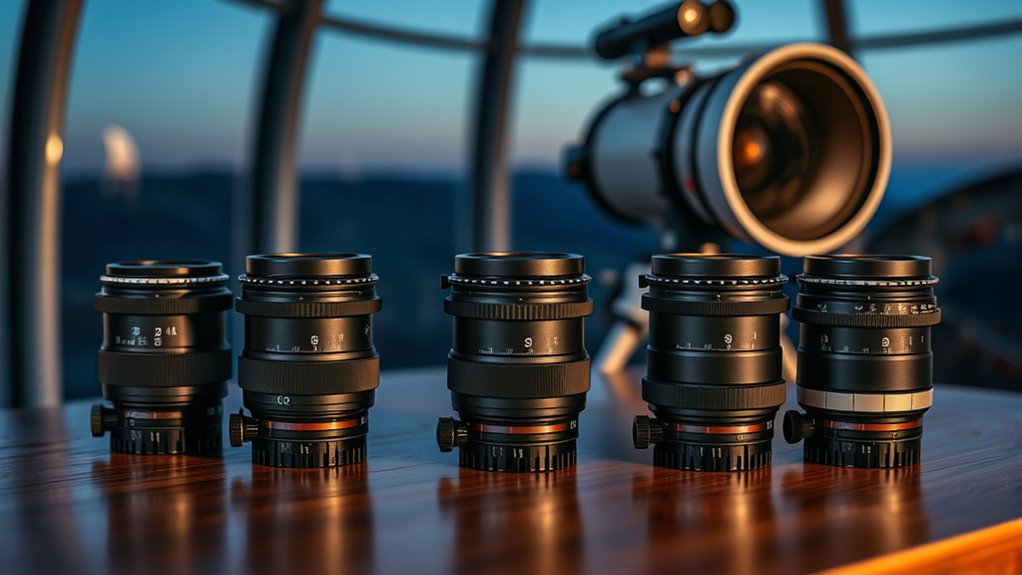If you’re looking for the best field flatteners for refractor telescopes in 2025, I recommend considering models like the SVBONY SV503 Refractor with built-in field flatteners, the SV193 2-inch Focal Reducer, Explore Scientific’s flat-field models, and the Astromania 2″ Flattener. These options are known for sharpness, durability, and compatibility with popular F-ratios. Keep in mind how each fits your setup, and if you continue, you’ll get more tips to choose the right one.
Key Takeaways
- The Explore Scientific Field Flattener offers excellent correction for refractors f/5 to f/7, ensuring sharp, distortion-free images.
- The Astromania 2″ Field Flattener provides full-aperture illumination and compatibility with various focal ratios, delivering consistent edge sharpness.
- The SV193 Focal Reducer & Field Flattener reduces focal length while maintaining high image quality across the entire field.
- The SVBONY field flatteners, like the SV503 built-in model, combine high-quality optics with ease of use for astrophotography.
- Durable, multi-coated designs from reputable brands ensure long-term performance and reliable results in 2025.
SVBONY SV503 Refractor Telescope, 102mm F7 Achromatic Refractor
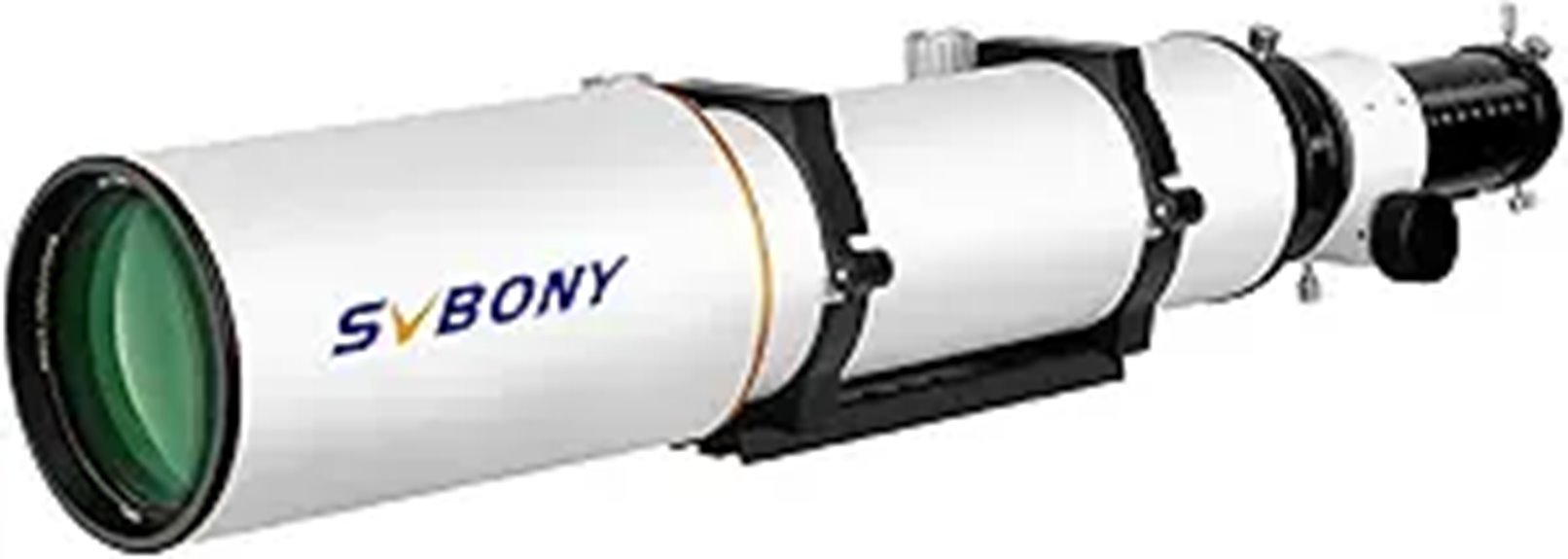
If you’re looking for a versatile refractor telescope that excels in both astrophotography and planetary observation, the SVBONY SV503 Refractor Telescope is an excellent choice. Its 102mm aperture and F7 focal ratio deliver bright, detailed images with minimal chromatic aberration thanks to the doublet air-spaced S-FPL51 ED glass. Fully multi-coated optics maximize light transmission and contrast. The dual-speed rack and pinion focuser ensures precise focusing, while the 360° field rotator simplifies framing shots. Plus, the 90mm back focus offers flexible accessory attachment. Whether you’re capturing deep sky objects or planetary details, this telescope provides high-quality optics in a portable, user-friendly design.
Best For: amateur astronomers and astrophotographers seeking a versatile, high-quality refractor telescope for deep sky imaging and planetary observation.
Pros:
- High-quality 102mm aperture with F7 focal ratio for bright, detailed images
- Doublet air-spaced S-FPL51 ED glass reduces chromatic aberration for clearer visuals
- Fully multi-coated optics maximize light transmission and contrast for superior image quality
Cons:
- Heavier and larger compared to smaller portable telescopes, may require additional setup time
- Not suitable for extremely high-magnification planetary imaging without additional accessories
- Requires careful handling and maintenance to keep the optical coatings and components in optimal condition
SVBONY SV193 Focal Reducer 2 Inch 0.8X Field Flattener
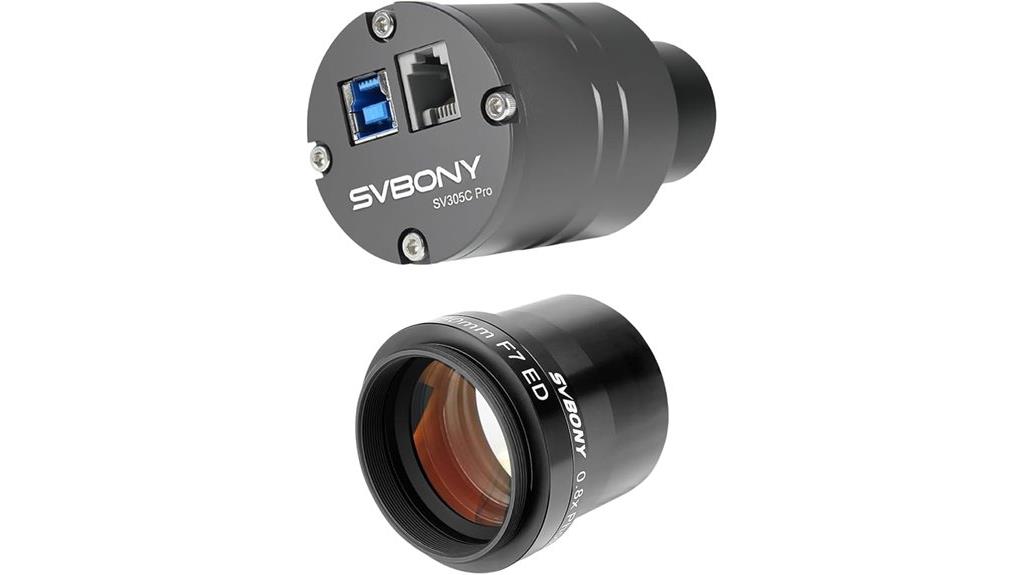
The SVBONY SV193 Focal Reducer 2 Inch 0.8X Field Flattener is an excellent choice for astrophotographers seeking sharp, wide-field images with minimal edge distortion. It reduces the focal length by 0.8x and flattens the field curvature, ensuring star points remain sharp across the entire image, even at the edges. Compatible with advanced refractors like the SV503 80ED, it features a 2-inch front socket and an M48x0.75 threaded back end for easy camera attachment, including full-frame sensors. This focal reducer delivers excellent illumination and minimizes star distortion, making it ideal for planetary and deep-sky astrophotography.
Best For: astrophotographers seeking high-quality, wide-field images with minimal edge distortion using refractor telescopes and full-frame sensors.
Pros:
- Reduces focal length by 0.8x for wider field of view and optimal illumination.
- Flattens the field curvature to maintain star sharpness across the entire image.
- Compatible with full-frame cameras and advanced refractors like SV503 80ED for versatile astrophotography.
Cons:
- May require precise threading or adapters for certain telescope setups.
- Potential vignetting if not properly aligned with the optical train.
- Slightly more expensive compared to standard reducers, depending on retailer.
SVBONY SV503 Refractor Telescope with Built-in Field Flattener and SV305C Camera

The SVBONY SV503 Refractor Telescope, equipped with a built-in field flattener and paired with the SV305C camera, stands out as an excellent choice for astronomers seeking sharp, distortion-free images across wide fields. Its flat-field design minimizes chromatic aberration and field curvature, delivering true-to-life colors and crisp details of galaxies, nebulae, and star clusters. With an F/6.78 focal ratio and 70mm aperture, it produces bright, clear images. The SV305C camera’s high sensitivity and low noise make it ideal for planetary and deep-sky imaging. Overall, this system provides high-quality visuals with minimal distortion, perfect for both visual and astrophotography enthusiasts.
Best For: amateur astronomers and astrophotographers seeking high-quality, wide-field, distortion-free images with minimal chromatic aberration and excellent planetary and deep-sky imaging capabilities.
Pros:
- Built-in field flattener ensures flat-field correction and wide, distortion-free views
- ED glass optics deliver true-to-life colors with minimal chromatic aberration
- High sensitivity SV305C camera captures detailed planetary images even in low light conditions
Cons:
- The 70mm aperture may limit brightness for very faint deep-sky objects compared to larger telescopes
- F/6.78 focal ratio might require precise tracking for long exposures
- Availability and pricing could vary, so checking current deals is recommended
Explore Scientific Field Flattener for Refractor Telescopes
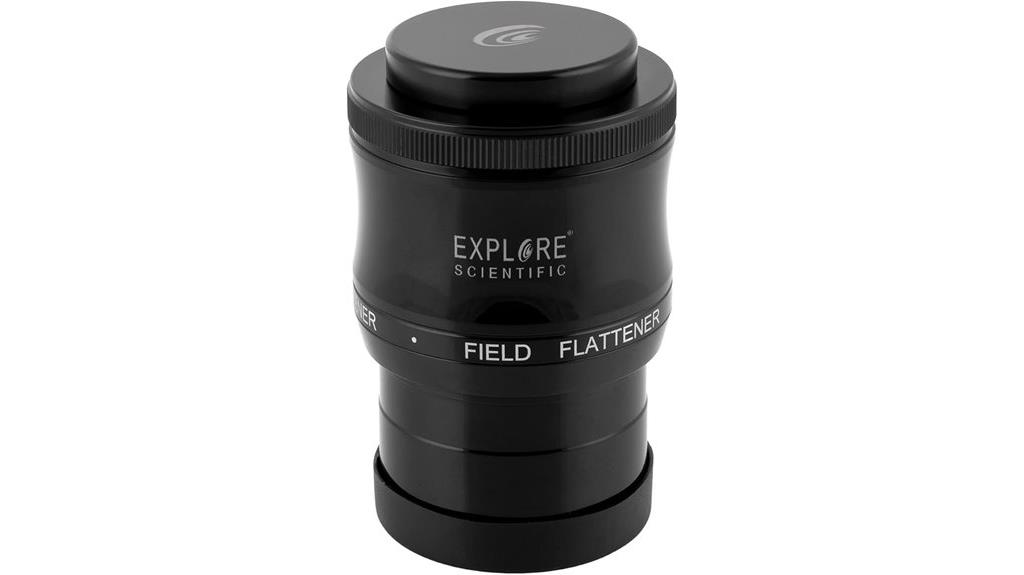
Photographers using refractor telescopes with focal ratios between f/5 and f/7 will find the Explore Scientific Field Flattener an excellent choice to achieve sharp, distortion-free images. It effectively minimizes star distortion caused by field curvature, ensuring pinpoint stars across the entire image. Its 55mm spacing requirement and T-ring compatibility make setup straightforward. Fully multi-coated optics maximize light transmission, boosting contrast and clarity. Compact and durable, it weighs just 4 pounds, perfect for portable astrophotography setups. Based in the USA, Explore Scientific offers reliable customer support. With top ratings and a strong reputation, this flattener is a dependable tool for capturing stunning celestial images.
Best For: astrophotographers using refractor telescopes with focal ratios between f/5 and f/7 seeking sharp, distortion-free images of celestial objects.
Pros:
- Effectively minimizes star distortion caused by field curvature for sharper images
- Fully multi-coated optics enhance light transmission, contrast, and clarity
- Compact, lightweight design (4 pounds) ideal for portable astrophotography setups
Cons:
- Requires precise 55mm (+/- 2mm) spacing between the flattener and camera sensor for optimal performance
- Compatible only with refractor telescopes within the specified focal ratio range (f/5 to f/7)
- May need additional accessories like a T-ring for camera attachment, depending on equipment
Astromania 2″ Field Flattener for Astronomy Photos
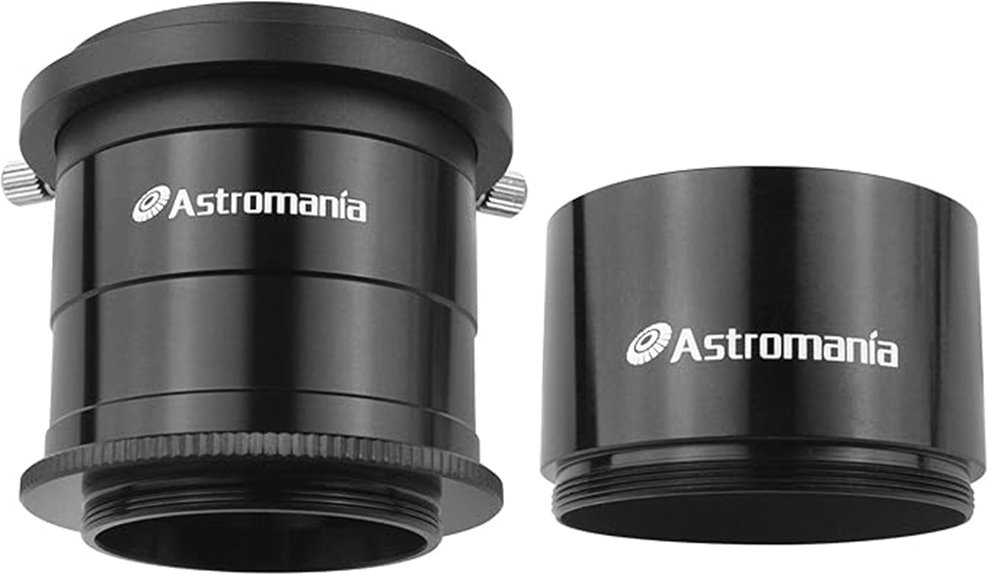
If you’re seeking a reliable field flattener that guarantees sharp, distortion-free images across your entire astrophotography frame, the Astromania 2″ Field Flattener is an excellent choice. It’s designed for refractors with focal ratios from f/4 to f/8, providing full aperture illumination via M48 threading. With a back focus of 109mm, it accommodates various accessories while effectively correcting field curvature. This flattener produces pin-sharp stars from center to edge, markedly enhancing image quality. Its multi-coated lenses improve light transmission and clarity, making it a dependable tool for capturing stunning, distortion-free astrophotos.
Best For: astrophotographers using refractor telescopes with focal ratios from f/4 to f/8 seeking sharp, distortion-free images across their entire frame.
Pros:
- Ensures pin-sharp stars from center to edge for high-quality astrophotography
- Corrects field curvature effectively, improving image flatness
- Multi-coated lenses enhance light transmission and image clarity
Cons:
- Designed specifically for refractors with f/4 to f/8, limiting compatibility with faster or slower systems
- Requires M48 threading and 109mm back focus, which may not fit all setups without adapters
- May be less effective for visual observing or small-chip photography where field curvature is negligible
Factors to Consider When Choosing Field Flatteners for Refractor Telescopes
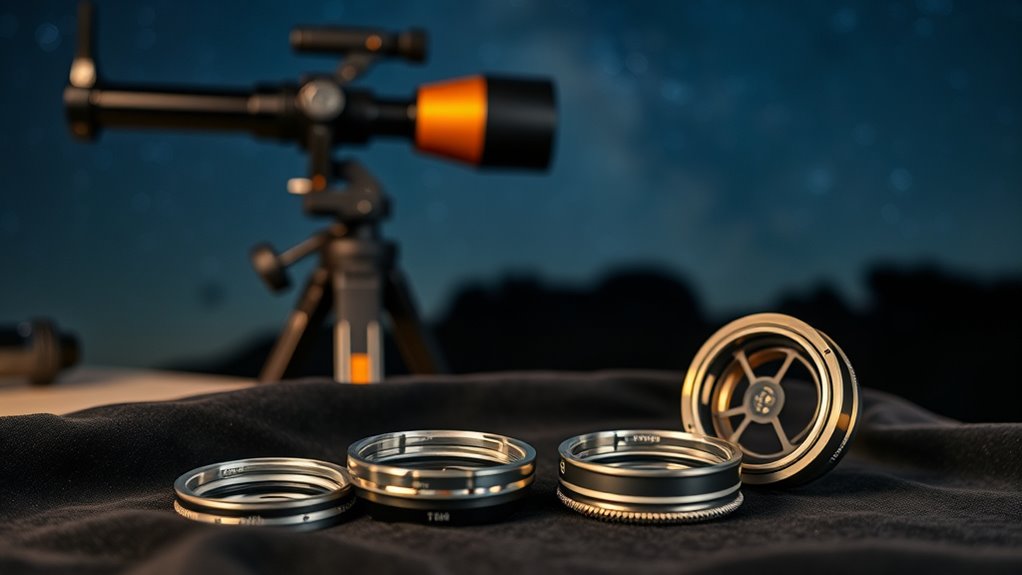
When selecting a field flattener, I consider factors like compatibility with my telescope’s F-ratio and the size of the field of view I need. I also look at optical coatings for better transmission, back focus requirements for proper focus, and how easy it is to install. These points help me find a flattener that suits my setup and imaging goals perfectly.
Compatibility With Telescope F-Ratio
Choosing the right field flattener depends heavily on your telescope’s focal ratio, as these accessories are specifically designed to optimize image quality within certain ranges. Most field flatteners work best with refractor telescopes that have focal ratios between f/5 and f/7 because they’re engineered to correct field curvature effectively within this scope. Using a flattener outside this recommended range can lead to less-than-ideal results, such as residual star distortion or vignetting, which compromises image sharpness. Many flatteners specify a compatible F-ratio, so it’s vital to match your telescope’s focal ratio to the flattener’s design. Proper matching ensures maximum image clarity, sharp stars, and minimal edge distortion, especially important for astrophotography or detailed observations.
Field of View Coverage
Have you ever noticed how some images lose sharpness or show distortion at the edges? That’s often due to inadequate field coverage. When choosing a field flattener, I look for one that provides a wide, corrected field of view, guaranteeing the entire image remains sharp from center to edge. The size of the flat field directly impacts how much of my telescope’s view is usable for detailed astrophotography. Since flatteners are optimized for specific focal ratios like f/5 to f/7, matching these ensures maximum coverage without vignetting. Proper spacing between the flattener and my camera sensor is essential to prevent star elongation and vignetting at the edges. A wider corrected field means I can capture larger sky areas, perfect for wide-field shots of nebulae or star clusters.
Optical Coatings and Transmission
Optical coatings play a crucial role in ensuring maximum light transmission through field flatteners, which directly impacts image brightness and clarity. Fully multi-coated (FMC) optics reduce reflections across multiple surfaces, allowing more light to pass through and resulting in brighter, sharper images. Anti-reflective coatings on flatteners and adapters help minimize stray light and glare, boosting contrast and overall image quality. High-quality coatings also improve transmission efficiency, so more light reaches the camera sensor or eyepiece, enhancing astrophotograph brightness. Additionally, proper coatings help reduce chromatic aberration and color fringing by preserving the integrity of different wavelengths. Durable coatings protect optical components from dust, moisture, and scratches, ensuring long-term performance and consistent image quality. Choosing a flattener with excellent coatings is essential for ideal viewing and imaging results.
Back Focus Requirements
Since the back focus distance plays a vital role in achieving sharp, well-corrected images, it’s important to understand the specific requirements of your field flattener. Different flatteners demand precise back focus distances, usually between 55mm and 109mm, measured from the flattener’s mounting flange to the camera sensor. Getting this distance right is essential for maintaining focus across the entire image and preventing star elongation or distortion. Many flatteners specify an exact back focus, like 55mm or 109mm, so measuring accurately and adjusting with spacers can fine-tune image sharpness at the edges. Using an incompatible back focus distance can cause vignetting, reduce image quality, or require extra adapters, so double-checking these specs is crucial before selecting a field flattener.
Ease of Installation
Choosing a field flattener that’s easy to install can make a big difference in your overall setup experience. Most models attach directly to your camera or eyepiece with straightforward mounting procedures, often using standardized threads like M48 or T-ring connections. These common fittings help guarantee a secure and hassle-free setup. Many flatteners also come with adjustable or flexible adapters, making it easier to fit different telescope and camera configurations. Proper spacing between the flattener and your camera sensor, usually specified by the manufacturer, is essential for excellent performance and is simple to achieve with the included instructions. Clear guidance and minimal tools make installation accessible, even for beginners. Overall, an easy-to-install field flattener saves time and reduces frustration during setup.
Image Edge Sharpness
A field flattener’s ability to produce sharp, well-focused stars across the entire image field is key to capturing high-quality astrophotos. Sharpness at the edges indicates effective correction of field curvature, ensuring consistent image quality from center to edge. The optical design, including lens coatings and proper element alignment, directly influences edge sharpness. Achieving ideal results also depends on maintaining the correct spacing between the flattener and the camera sensor, as this minimizes aberrations and enhances clarity. High-quality flatteners preserve contrast and reduce distortions, contributing to a crisp, detailed image across the entire field. When selecting a flattener, look for one that emphasizes edge-to-edge sharpness, ensuring your astrophotos are sharp, detailed, and free of distracting aberrations from edge to edge.
Build Quality and Durability
When selecting a field flattener, it’s vital to evaluate its build quality and durability, as these factors directly impact its long-term performance. High-quality flatteners are made with durable, fully multi-coated optics that resist environmental damage and frequent handling. Robust metal housings and secure threading ensure the device stays reliable and maintains alignment over time. Precise manufacturing tolerances are essential to prevent image degradation and ensure consistent optical performance. Well-built flatteners feature stable connections with standard threading sizes, reducing the risk of damage during attachment or removal. Durability also depends on the internal components, like precision-engineered lens elements and sturdy focusing mechanisms. Investing in a well-constructed flattener guarantees longevity and consistent results, making it a dependable choice for serious astrophotographers.
Price and Value
The price of field flatteners can vary greatly, from budget-friendly options under $50 to premium models exceeding $200. While cheaper flatteners may save you money upfront, they often lack the optical quality, coatings, and precise correction found in higher-end models. Investing in a more expensive flattener can provide better image performance, thanks to improved materials and construction. When considering value, it’s essential to weigh durability and long-term usability alongside the initial cost. Comparing the price-to-performance ratio helps determine if a pricier model offers meaningful benefits over more affordable options. Customer reviews and ratings are also valuable, as they reveal whether a particular flattener justifies its cost by delivering consistent, high-quality results over time.
Frequently Asked Questions
How Do Field Flatteners Affect Image Distortion in Refractor Telescopes?
Field flatteners considerably reduce image distortion in refractor telescopes by correcting curvature caused by the lens system. I’ve found that they produce sharper, more consistent images across the entire field of view. Without one, edges tend to be warped or blurred, but adding a flattener helps maintain focus and detail from center to edge. It’s a game-changer for astrophotography and detailed planetary viewing, ensuring clarity throughout your observation.
Can Field Flatteners Be Used With Astrophotography Cameras Other Than Those Listed?
Absolutely, you can use field flatteners with other astrophotography cameras beyond those listed. It’s almost surprising, right? Many flatteners are designed to be versatile, fitting various camera mounts and sensor sizes. Just check the compatibility specs before buying. No need to stick with only a few options—most flatteners work well across different setups, making them a handy tool for any astrophotographer aiming for sharp, flat images.
Do All Refractor Telescopes Require a Field Flattener for Wide-Field Imaging?
Not all refractor telescopes need a field flattener for wide-field imaging, but many do, especially faster models with a focal ratio of f/5 or lower. I recommend checking your telescope’s specifications; if you notice star distortions at the edges, a flattener will help. For ideal images, I always use a field flattener when capturing wide-field astrophotos, ensuring sharp, distortion-free results across the entire frame.
What Is the Typical Lifespan of a High-Quality Field Flattener?
A high-quality field flattener typically lasts around 10 to 15 years, but honestly, with careful handling, I’ve seen some last even longer—decades, in fact. It’s almost ironic how something so small and delicate can serve you through countless nights of stargazing. Proper cleaning and storage are key, though. So, if you treasure your gear, you’ll keep it performing beautifully for many years to come.
Are There Compatibility Issues Between Different Brands of Field Flatteners and Telescopes?
Compatibility can be an issue between different brands of field flatteners and telescopes. I’ve found that matching the flattener’s thread size and focal length with my telescope’s specifications is essential. Sometimes, adapters are needed to guarantee a perfect fit. I always double-check manufacturer guidelines and user reviews to avoid compatibility problems, which helps me get the best performance and sharp images without frustration.
Conclusion
So there you have it—your VIP list of field flatteners for 2025. Because, clearly, nothing says “I’m serious about astronomy” like obsessing over perfect star fields. Whether you choose the trusted SVBONY, Explore Scientific, or Astromania, just remember: in the end, it’s not about the gear, but about pretending your backyard galaxy tour is NASA-worthy. Happy stargazing, and may your images be ever so slightly less embarrassing.
